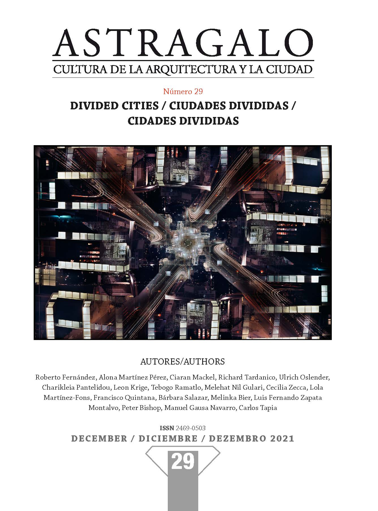Boxed in
Challenges of escaping the inherited spatial realities of apartheid from the centre to the periphery
DOI:
https://doi.org/10.12795/astragalo.2021.i29.08Keywords:
African cities, Johannesburg, spatial fragmentation, spatial defragmentation, inherited spatial realitiesAbstract
This paper interrogates the existing spatial realities of Johannesburg as it was shaped by colonialism and the challenges of providing an inclusive urbanism between the centre, the periphery and the in-between. Johannesburg is a major urban centre in South Africa, and Southern Africa, with increasing economic and spatial inequality. The inherited spatial realities are still evident today; these structural realities are restrictive, unsustainable, and disadvantage communities ecologically, economically and socially. The paper is premised on an understanding that economic inequality is related to spatial inequality.
The author draws on the personal lived experiences of being born on the periphery and the limitations of escaping the legacies of colonial spatial planning including the challenges of living on fragmented urban morphology. The author looks at the typology of the segregated post-apartheid township and the negative elements of apartheid spatial planning, especially focused at the restrictions it has on housing, employment opportunities, transport and public space on the periphery in comparison to the centre and how the in-between spaces further perpetuate socio-economic disparity. The author attempts through research to understand the resilience adopted by the Soweto community to have a safe and welcoming place despite the persistence of structural restrictions. The intention is to address the fragmentation and segregation caused by the inherited spatial structures.
The planning of colonial cities, especially Johannesburg was based on achieving maximum control. The urban morphology was many times based on policies that organised people through race, class, and ethnicity. Its spatial planning was defined by separating citizens into different racial groups and economic classes. The rich white people located in the suburbs in the centre and the poor black people located in townships at the periphery separated by wide natural and man-made buffers in-between. The urban morphology of Johannesburg will be studied with a comparison analysis with other African cities which have similar patterns of spatial fragmentation in urban form due to colonial powers. The aim is to observe, compare and propose a defragmentation process towards the transformation of Johannesburg.
Downloads
Metrics
References
African Development Bank Group. 2018. Nigeria - Eko Atlantic City Development, Lagos, Nigeria – Shoreline Protection, Land Reclamation and City Masterplanning – ESIA Summary. [O]. Available from: https://www.afdb.org/en/documents/document/nigeria-eko-atlantic-city-development-lagos-nigeria-shoreline-protection-land-reclamation-and-city-masterplanning-esia-summary-106865. Accessed 16/07/2020.
Angel, Shlomo. 2018. New Urban Peripheries- Essays _Urban Age. LSE cities, p1. [O]. Available from: https://urbanage.lsecities.net/essays/new-urban-peripheries. Accessed 5/06/2020.
Badawy, Aya, Abdel-Salam, Hassan and Ayad, Hany. 2015. Investigating the impact of urban planning policies on urban division in Cairo, Egypt: The case of El-Maadi and Dar El-Salam. [O]. Available from: http://www.elsvier.com/locate/aej, [Accessed 13/05/2020].
Baruah, Neeraj, Henderson, J Vernon and Peng, Cong. 2017. Colonial Legacies: Shaping African Cities. [O]. Available: http://eprints.lse.ac.uk/86574/1/sercdp0226.pdf. Accessed: 13/05/2020.
Bremner, Lindsay. 1998-2008. Writing the City into Being: Essays on Johannesburg. Johannesburg: Fouthwall
Chipkin, Clive. 2008. Johannesburg Transition: Architecture & Society from the 1950. Johannesburg: STE Publishers.
Demissie, Fassil. 2012. Colonial Architecture and Urbanism in Africa, Intertwined and Contested Histories. London: Routledge.
Fang, Chuanglin and Yu, Danlin. 2017. Urban agglomeration: An evolving concept of an emerging phenomenon. [O]. Available from: http://www.elsevier.com/locate/landurbanplan. Accessed 13/05/2020.
Graafland, Arie. 2012. African Perspectives- South Africa. City, Society, Space, Literature and Architecture. Rotterdam: 010 Publishers
Haylett, Chris. 2003. Culture, Class and Urban Policy: Reconsidering Equality. 35:55-73. [O]. Available from: https://doi.org/10.1111/1467-8330.00302. Accessed 17/06/2020.
Jimenez, Lai. 2012. Citizens of No Place: An Architectural Graphic Novel. New York: Princeton Architectural Press.
Khalifa, Marwa, Van Nes, Akkelies, Salheen, Mohamed and Hamhaber, Johannes. 2014. Understanding urban segregation in Cairo: The social and spatial logic of a fragmented city. [O]. Available from: http://www.researchgate.net/publication/276285052. Accessed 20/05/2020.
Kreutzfeldt, Dorothee and Malcomess, Bettina. 2013. Johannesburg Not No Place. Johannesburg. Jacana Press.
Lall, Somik, Henderson, J Vernon and Venables, Anthony. 2017. African Cities: Opening Doors to the world. World Bank, Washington, DC. [O]. Available from: http://elibrary.worldbank.org/doi/book/10.1596/978-1-4648-1044-2. Accessed 20/05/2020.
Lepofsky, Jonathan and Fraser, James. 2003. Building Community Citizens: Claiming the Right to Place-Making in the City: 127-142. [O]. Available from: http://www.researchgate.net/publication. Accessed 26/05/2020.
Mahmoud, Randa A and Rashed, R. 2016. New Cairo's Urban Paradox: All-Inclusive Urbanism vs. Social Exclusion. SBE16-Cairo. [O]. Available from: https://www.researchgate.net/publication/333798565. Accessed 18/07/2020.
Mbembe, Achille and Nutall, Sarah. 2007. The Elusive Metropolis. Johannesburg: Wits University Press.
Moreno, Eduardo. 2018. Urbanisation Trends- Essays _Urban Age. LSE cities, p1. [O]. Available from: https://urbanage.lsecities.net/essays/urbanisation-trends. Accessed on 20/06/2020.
Morphet, Tony. 1998. “Personal Traits: The work of Eaton and Bierman in Durban”. Blank_ Architecture, Apartheid and After, editado por Judin, H. & Vladislavic, I. Rotterdam: NAi Publishers 5:148-161.
Mushongera, Darlington and Gotz, Gauteng. 2015. Gauteng city-region observatory quality of life survey: Changing social fabrication- Inequality. [O]. Available: http://www.gcro.ac.za. Accessed 15/05/2020.
Nnamdi, Elleh. 1997. African Architecture: evolution and transformation. New York: The Mcgraw – Hill Companies.
Obiadi, Bons and Nzewi, Ugochukwu Nzewi. 2018. “The Creation of Abuja, Nigeria Slums: A case of Abuja, Nigeria’s failed Master Plan Implementation”. [O]. Journal of Trend in Scientific Research and Development (IJTSRD). Available: www.ijtsrd.com. International ISSN, 2:2456-6470.
Pieterse, Edgar. 2009. African Cities: Grasping the unknowable. Inaugural lecture, 1. [O]. Available from: https://www.alnap.org/system/files/content/resource/files/main/grasping-the-unknowable-26-august-09.pdf. Accessed June 2020.
Sands, Melissa L. 2017. Exposure to inequality affects support for redistribution. Proceedings of the National Academy of Sciences, 114(4), 663-668. [O]. Available: http://www.pnas.org/cgi/doi/10.1073/pnas.1615010113 [Accessed 20/06/2020].
Watson, Vanessa. 2013. “African urban fantasies: dreams or nightmares?” International Institute for Environment and Development (IIED). [O], 26(1): 215–231. Available from: www.sagepublications.com. Accessed 18/07/2020.
Downloads
Published
How to Cite
Issue
Section
License
Copyright (c) 2021 Tebogo Ramatlo

This work is licensed under a Creative Commons Attribution-NonCommercial-ShareAlike 4.0 International License.
- Abstract 274
- PDF 65


















